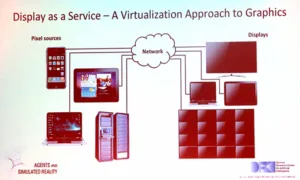Steve mentions in his report in this issue that the interest at DSE from Google might be related to the idea that Digital Signage might just become part of the “Internet of Things” (IOT). I can see what he means and we have been reporting on developments that might suggest this.
It seems to me that one of the key concepts that is central to this is the idea of “Display as a Service”. I was reminded of this technology earlier this week as I was at CeBIT and spoke to the University of Saarland, which has been working with Intel on this concept. DaaS was launched at the Hannover show in 2013, although there was no news on the idea at this year’s CeBIT. In fact, the last entry to the DaaS blog was from CeBIT 2013.
The idea of DaaS is that applications can send pixels to displays without worrying if there is a directly connected display and without worrying about the detailed specification of the final display device. The display image is created on the source device, then compressed and transmitted over a network to the final display, where it may be combined with other images and where the limits and features of the final display device are taken into account (borders, bezels, aspect ratios, whether it’s a video wall etc) and the final image rendered. Equally, the display device can look around for content from “pixel providers” and blend those into an image for display. You can easily see how those approaches might be attractive to makers of “headless” IoT devices which could look around for a display to show their data.
This kind of “display virtualisation” is a very powerful concept. It’s basically the same kind of approach that has seen the development of the idea of the “Virtual STB” by Active Video Networks that we have been writing about since 2010 and which is gradually getting into the TV market. It’s also behind the remote provision of workstation performance by RealVNC and AMD that we report on from CeBIT. Nvidia has also shown impressive game play over the internet to us in the past, and I have raved over several years about the “Project Fresco” research project that NDS started developing before it was acquired by Cisco and which won prizes for Cisco in 2013.
Matt wrote about technology from Userful that uses some of the same concepts in the same space in his Display Daily article in December.
So, we have Intel, Cisco and Google working away on this, among many others including high tech start-ups in software and networking – there’s a lot of activity.
Now, the challenge of display interfaces is always the sheer number of bits that needed to be transmitted. We see this challenge in our story in this issue on the new HP wireless display dock – the bandwidth needed and that consequent high frequencies of the radio means that ranges are very limited.
To get the bandwidth requirement down needs compression and then you run into two problems. Compress too much and you start to lose data – and the human visual system is very sensitive to the visual artefacts from lossy compression on graphics content (if not so much on video).
Compression and de-compression also takes time, which introduces latency, and the more sophisticated the codec, the more silicon you need. That’s the trade off going from MPEG2 to MPEG4/H.264 to H.265/HEVC. Adding the decompression hardware tends to increase the cost of your display “end points”. However, in IOT and digital signage applications, unlike desktop applications, latency is not a big issue.
Given a flat level of display quality delivery, you could see how quickly improvements in networks, the codecs and the chips that run them could be successful. However, the demands of users of displays go up and up in terms of resolutions, colours, refresh rates and dynamic range, offsetting the gains made elsewhere.
On that basis, it looks as though it will be a while before direct display interfaces are just a part of display history!
Bob

